The best new African safari camps
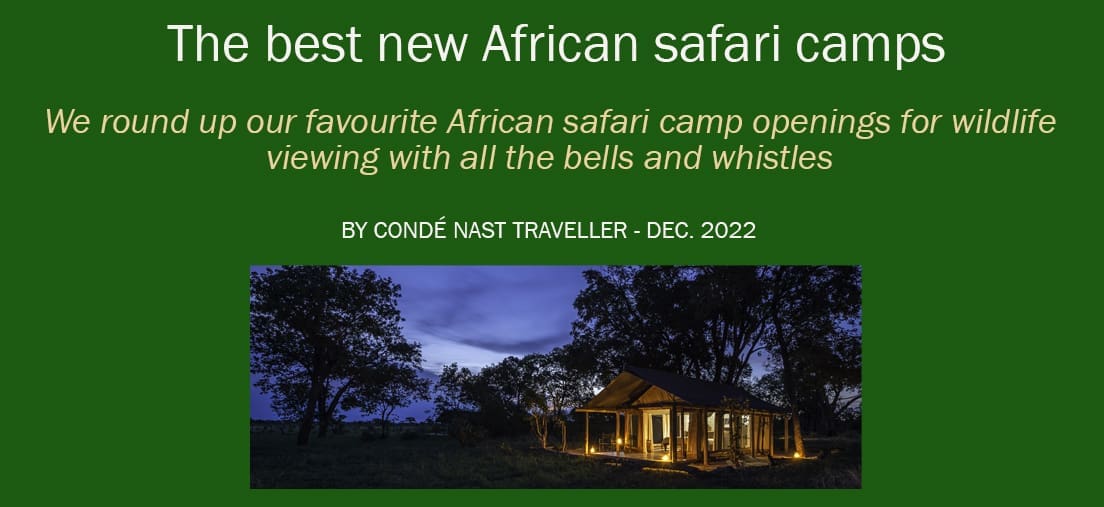
An African safari is one of those once-in-a-lifetime experiences that every traveller should have. To be among some of the world’s most captivating wildlife and untouched landscapes on the planet, just a few feet away from leopards lounging on trees or gazelles galivanting across the Lower Zambezi, is a feeling far unmatched by a cityscape. And with a host of new African safari camps, there isn’t a better time to venture into the wilderness than now…
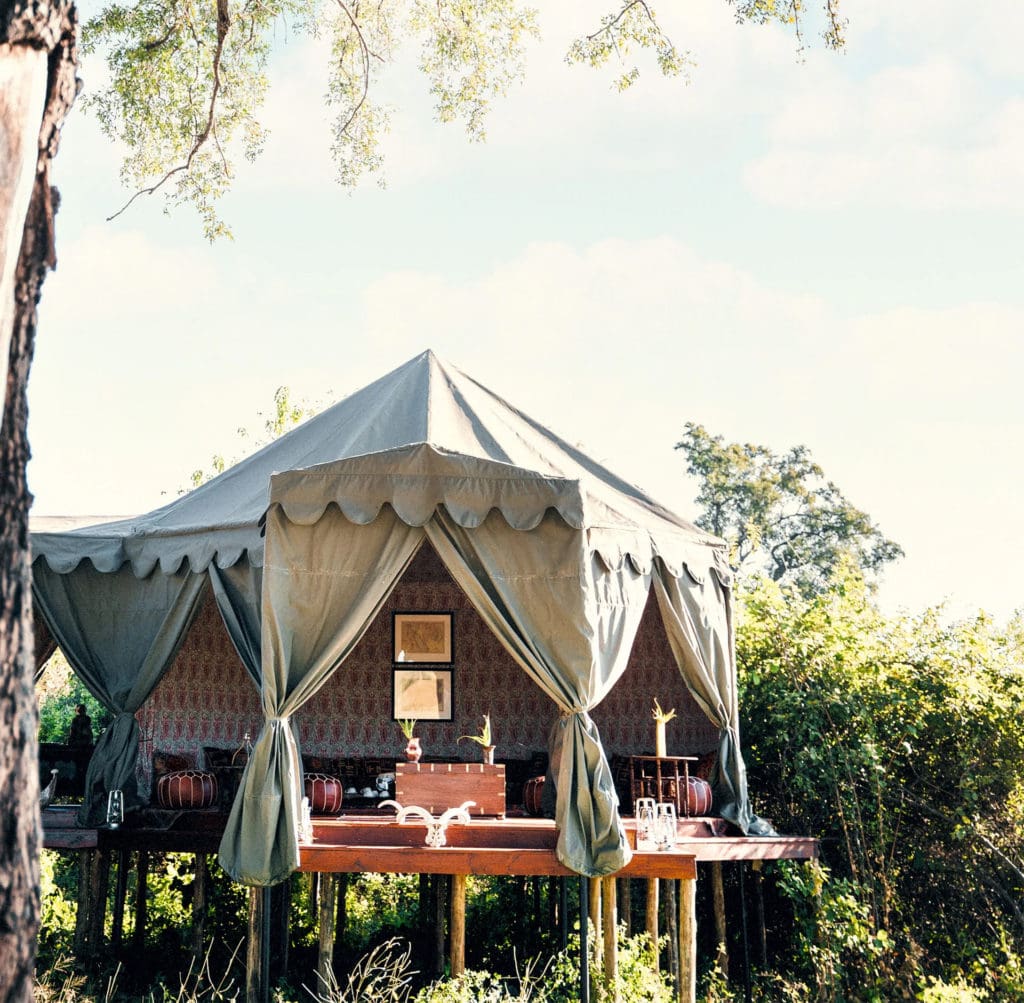
Duke’s Camp – Okavango Delta, Botswana
Thirty year ago, Jack’s Camp blazed on to the safari scene, pioneering the under-canvas luxury safari in Botswana’s Makgadikgadi Pans. Three decades later, sister camp Duke’s has opened in the northern Okavango Delta. It is named in honour of 80-year-old Sarefo “Duke” Sarefo, the official custodian of the land. The camp is set in the Moremi Game Reserve, home to hundreds-strong elephant herds, wild dogs, lions and leopards that occasionally lounge in trees. On the gin-clear water of the delta, which wiggles its way through the camp, sapphire-backed malachite kingfishers pose next to water lilies. They can be spotted from the camp’s mokoro dug-out canoes; from the sun-drenched deck and plunge pool; from the eight eccentrically styled tents (four more are in planning), with large decks for delta-watching. Inside the tents, wooden four-poster beds with scalloped canopies are topped with cosy feather-filled duvets and pinstripe linen. Paisley fabric is draped from the ceiling and vibrant floral cushions are scattered on armchairs. Bathrooms hark back to the 1920s, with brass fittings and mahogany dresser tables. There’s a theatrical vibe in the communal Bedouin-style dining area, where velvet sofas, Persian rugs and silky pouffes circle a low table often topped with silver tea pots and muffins. Sunlight floods in during the day; by evening it is transformed into a cosy lantern-lit dining area and bar. Hannah Summers
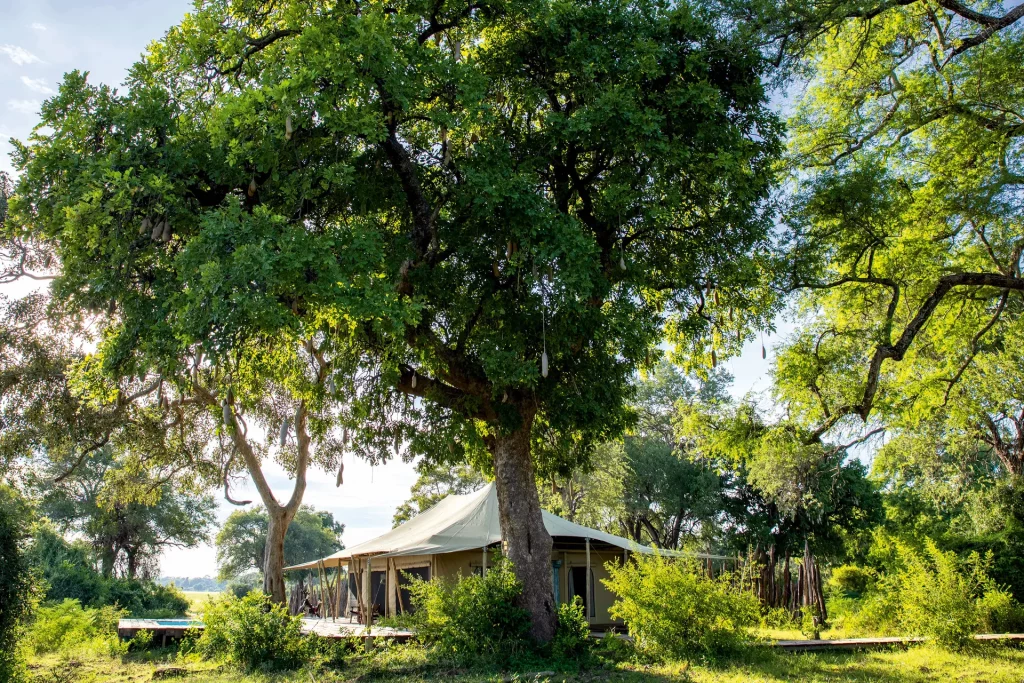
Tembo Plains Camp – Mana Pools, Zimbabwe
It wasn’t always so easy to sit and watch a relaxed bull elephant tug grass from the ground at the edge of the Zambezi before gently shaking it off in the river. But Tembo Plains Camp, in the Sapi Reserve east of Mana Pools, is the result of a remarkable relocation project by conservationists Dereck and Beverly Joubert and their Great Plains Foundation. Having seen the wildlife overpopulation in the Savé Valley Conservancy in Southern Zimbabwe, the Jouberts began Project Rewild Zambezi, an ongoing plan to relocate more than 3,000 animals 600 miles north to the under-populated Sapi Reserve, including 400 elephants, painted dogs, lions, buffaloes, impalas and more. Tembo Plains, tucked into a forest by a hippo-friendly stretch of the Zambezi, is a classically styled camp, with canopied beds and wildlife-friendly cameras provided in each of the four suites, as well as wooden decks and private pools looking over the river. The staff are some of the warmest in southern Africa, including charismatic manager Lloyd Mushure, who serves G&Ts and stories while angling for tiger fish or on canoe trips spotting hippos and crocodiles. In camp, the steady flow of the river provides a hypnotic backdrop to massages, fireside drinks and Zimbabwean dishes such as Lake Harvest bream curry. Hannah Summers
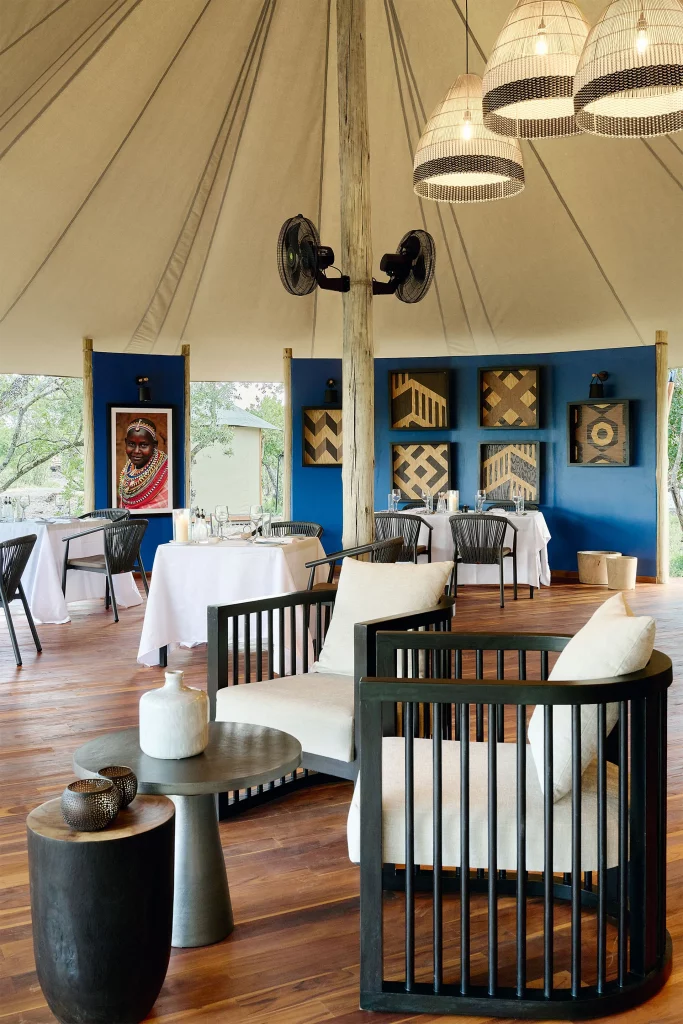
Sanctuary Tambarare – Ol Pejeta Conservancy, Kenya
In a corner of the 90,000-acre Ol Pejeta Conservancy, two females have achieved superstar status. Najin and her daughter Fatu are the last remaining northern white rhinos in the world. Their eggs are safely preserved in a hi-tech lab in Italy in the hope of continuing the species via IVF. For now, a new tented camp – Sanctuary Tambarare – offers a welcome base from which to visit these wildlife sensations, whose diets are lovingly and obsessively monitored and who are protected 24/7 by armed guards. Tambarare’s 10 luxury tents, each different but embracing a simple, golden-age-of-safari look, with billowing white curtains, are ensconced in fever trees under the shadow of Mount Kenya. Their deep-blue walls are dotted with Masai-inspired artwork, and there are private verandas with epic grassland views. Reports indicate that Africa’s rhino population dropped by a staggering 97 per cent in less than 30 years. In 1993, only 2,300 wild rhinos remained. Today that number has more than doubled, and Ol Pejeta is home to nearly 150 critically endangered black rhinos – the largest sanctuary for the animals in East and Central Africa. Here, you can ride horses alongside the rhinos and zebras, cycle across the Laikipia plains; walk past the hippos wallowing in the Ewaso Nyiro River or night-ride past polecats, bat-eared foxes and aardvark (a privilege banned in most Kenyan national parks and reserves). Tambarare can sign you up to meet the local anti-poaching canine unit (the bloodhounds are friendlier than you might imagine) and the park’s rapid-response team, who deal with everything from first aid to chasing bandits. Divia Thani
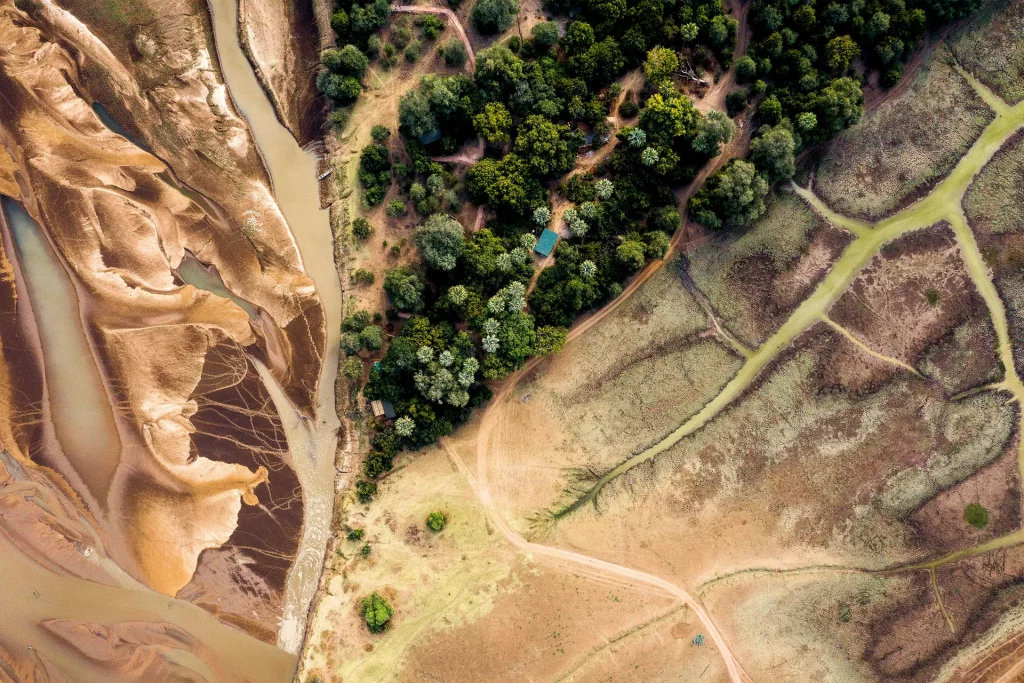
Sungani And Kulandila – South Luangwa National Park, Zambia
When the Davy family decided to create their own safari camp (having run Anabezi, on the Zambezi, for relatives), the far south-western part of Zambia’s game-rich South Luangwa National Park was fairly untouched. But it had access to nearly 70,000 acres of wilderness and only one other camp nearby. In 2019 they took up the challenge, moving into a couple of tents and designing and building eight-bedroom Sungani, as well as the nearby private-use safari camp Kulandila. Both feel like elegant, welcoming family bush homes, efficiently run by mother and father Lynne and Paul. Their son Michael expertly oversees the walks, canoe trips, boat rides and game drives, while moreish meals are masterminded by former Singita chef Quinton Spocter – from French-patisserie-standard tea spreads to evening feasts that might include delicate Malay-spiced fish or fire-cooked beef. Each of Sungani’s spacious villa-style, canvas-walled rooms is linked by wooden platforms, below which animals can roam – by day warthogs and, at night, hippos waddling from their lily-covered oxbow lagoon. With netted beds, airy living rooms, big baths and outdoor showers, the classic tents are soothing spaces from which to birdwatch or lounge by a plunge pool before heading into the wild to enjoy prolific game: leopards, lions and wild dogs, and almost 500 species of birds. The delivery of a plane and the new Luangwa airstrip means the bumpy if interesting three-hour road trip from Mfuwe is now optional. Lisa Grainger
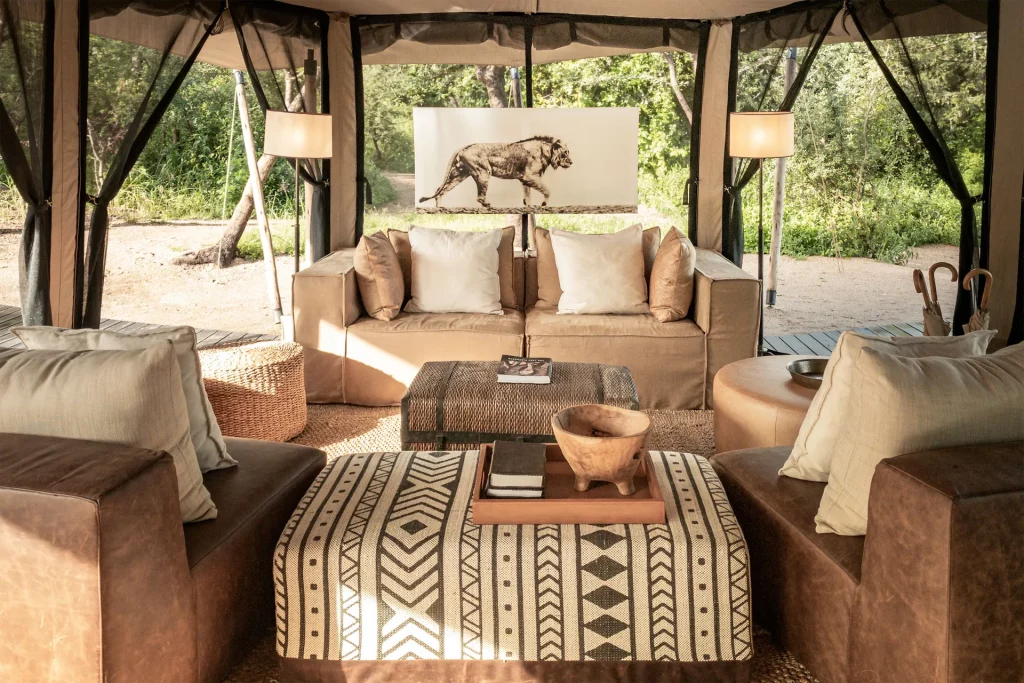
Mila Tented Camp – Western Serengeti, Tanzania
It’s easy to become blasé about the herds of eland, topi, Thomson’s gazelle, zebra, giraffe and wildebeest grazing around this explorer-style camp in the western Serengeti’s Nyasirori area. Very close to the Grumeti River, where hippos jostle and giant crocodiles bask, it’s free of crowds even at the height of the migration. Brilliant year-round wildlife viewing is the reason Mila went from being a seasonal camp to a permanent one, debuting this May with five tents and a two-bedroom family option in the tawny grasslands. The interiors are romantic yet restrained, and natural fibres rule, from deep khaki Italian-cotton bedsheets to linen throws, slip-covered sofas and handwoven jute underfoot. Reclining leather chairs and bean bags are perfectly positioned to spot jackals and hyenas slinking across the open plains. Multiple mess tents mean not having to share space, so private dining is the norm, and everyone gets a private vehicle. Chefs rotate between Legendary Safaris’ camps, keeping standards high in the humble tented kitchens. An authentic Swahili feast wows as much as chilled pea soup with a swirl of chilli oil followed by seared beef or gnocchi, butternut churros and masala chai. When the morning safari is too good to miss, breakfast is delivered wherever you are – fresh fruit, croissants with pineapple jam, East African-style omelettes and strong Tanzanian coffee. This is the way to safari, with a real sense of intimacy with the wild, vast landscape. Jane Broughton
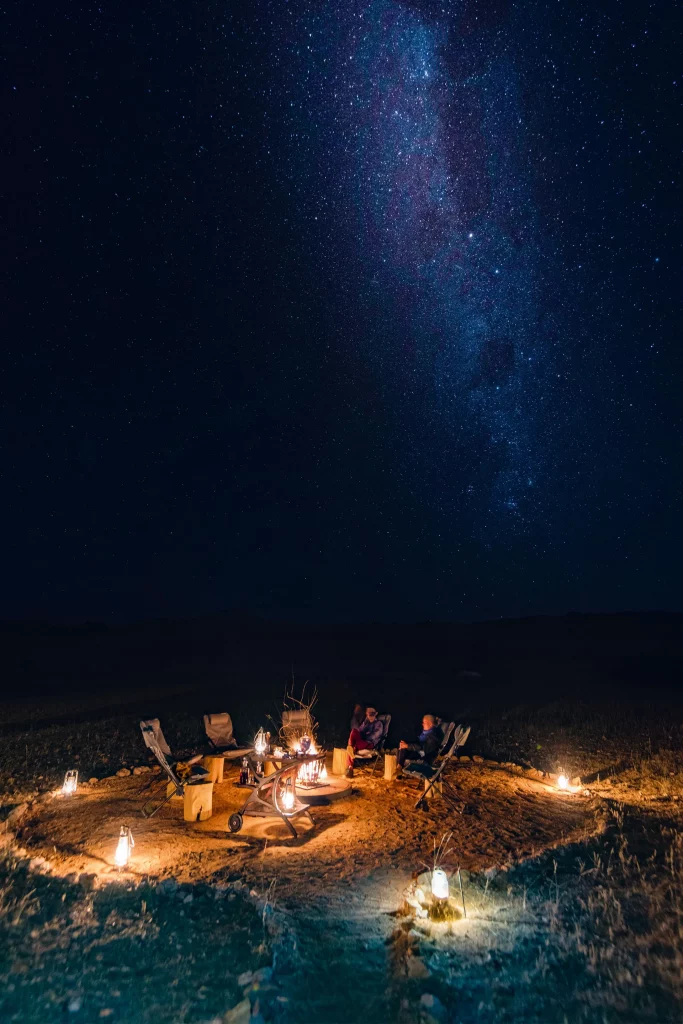
Camp Sossus – Sossusvlei, Namibia
It’s no surprise that the deserts of Namibia are regularly used as backdrops for sci-fi movies; few places look as unearthly. On a 60,000-acre private concession bordering the World Heritage Site of the Namib Sand Sea, Ultimate Safaris’ founder Tristan Cowley has created an eco desert camp that makes this Mars-like environment not only habitable but comfortable. Every detail has been designed so visitors can connect with nature: the six newly redesigned canvas-and-mesh-walled rooms, clad with protective, rust-coloured “skins” made from recycled oil drums, now have open-air bathrooms with star beds so guests can shower and sleep under the clearest skies on the planet. Private outside areas have shaded day-beds sited to trap cooling westerly breezes for afternoon naps, and a deck has been expanded for sunset yoga, sundowners and lamp-lit dinners. Unlike at most other desert camps, here guests have the family-friendly private reserve to themselves: to walk or mountain bike, to watch zebras and oryx graze on shimmering grasslands, to swim in spring-filled bush pools, to dine on summits with views of the rippling Tsaris Mountains and the mammoth dunes of nearby Sossusvlei. Best of all, Cowley is one of Namibia’s leading guides, and for Sossus, as with the camp he launched on Onduli Ridge in Damaraland last year, he has created immersive experiences from children’s botany walks and family cycle rides to astronomy lessons by the fire. The camp can be taken privately, as can Namibia’s most inventively designed home, The Nest, tucked up in the hills like a giant thatched bird’s nest. Lisa Grainger
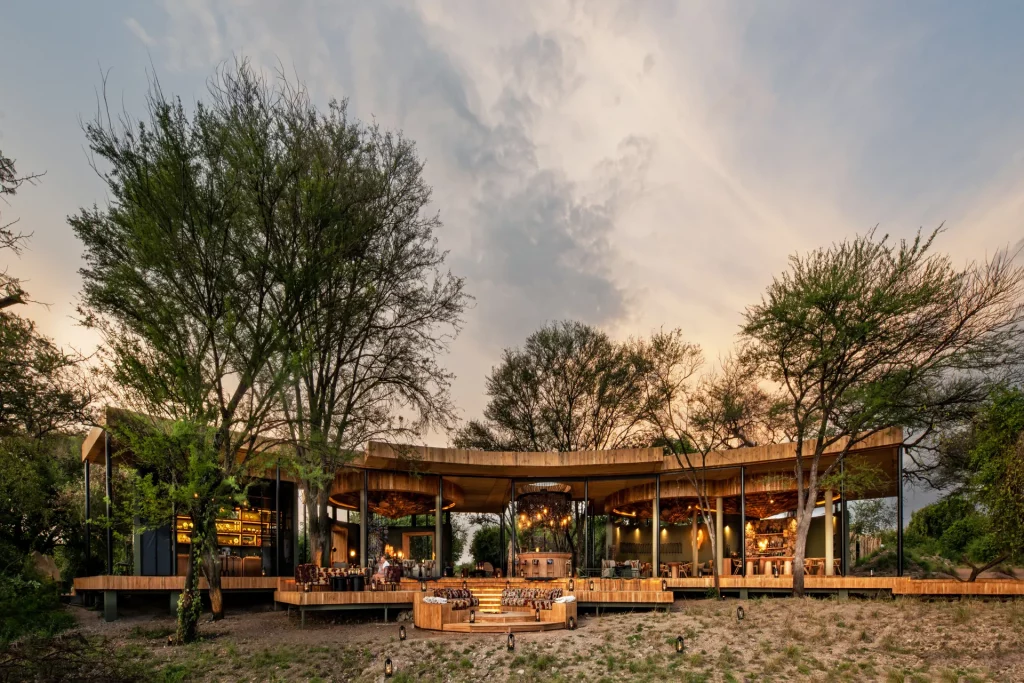
Grumeti Serengeti River Lodge – Serengeti National Park, Tanzania
The site of the greatest migration on Earth, Serengeti National Park has become increasingly busy – with more than 40 vehicles at some river crossings. But because andBeyond’s Grumeti Serengeti property is in the far north-west, with few other camps around, wildlife spotting here is relatively private. That is, if you can tear yourself away from the rebuilt designer lodge. Strung above the Grumeti River, in which pods of hippos harrumph and baboons screech, 10 teak-clad modernist villas lie either side of an open-fronted living area, with decks dropping towards the water. As with the company’s other star project, Lolebezi in Zambia, designers Fox Browne have made this Tanzanian outpost a showcase for contemporary pan-African design: kitenge-covered pouffes alongside hand-woven sisal tables; wooden bamileke tables from West Africa, beaded Namji dolls and a collection of artefacts. For those who don’t want to go on the twice-daily game drives (on which lions are pretty much guaranteed year-round, alongside hundreds of thousands of migrating wildebeest in June and July), there is a circular pool to laze beside, plus morning walks, in-room massages and yoga sessions. In the evening guests converge around a central domed bar lit by orbs of locally blown glass, before migrating to a boma dinner, cigars around a star-lit fire pit and late-night whiskies beside their private plunge pool. Lisa Grainger
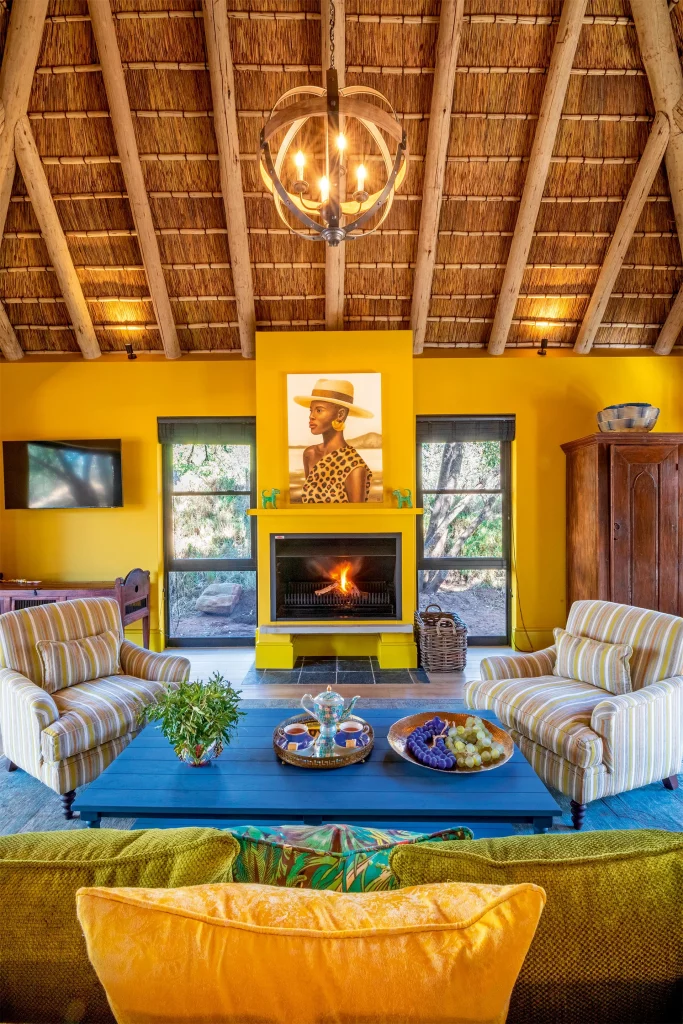
Waterside At Royal Malewane – Greater Kruger National Park, South Africa
Along with enviable locations and pitch-perfect service, lived-in opulence has become a trademark of the Royal Portfolio’s South African hotel collection. Not too far from where it all began at Royal Malewane 22 years ago, this latest addition to Thornybush – a private game reserve that forms part of the Greater Kruger conservation area – feels more like a private home than a hotel. Owner Liz Biden has gone all out to create lavishly layered spaces where jewel-bright colours enliven everything from rugs to walls, antiques to repurposed junkyard salvages. This is a theatrical, transportive experience that amplifies rather than detracts from the vibrancy of the surrounding bush, which crackles with life deep into the night. Even the luminous fever trees, towering above the thatched lodge on the water’s edge, look like they’ve been touched up. There are seven suites with one or two bedrooms, as well as a four-bedroom villa – all with solar-heated pools and air-conditioning that runs on solar power and recycled water. A buzzing open-air bar serves cocktails made with local spirits, and a sommelier picks bottles from the wine cellar to enjoy with seasonal menus. There are many reasons to stay in camp, including a library, lap pool, gym, yoga studio and spa, plus a games room geared to children of all ages – but there are also 34,600 acres waiting to be explored by vehicle or on foot. From birding to epic sightings of lion prides and wild dogs, every outing is amplified in the company of experienced guides and trackers who, collectively, have the highest professional qualifications in the business. Jane Broughton
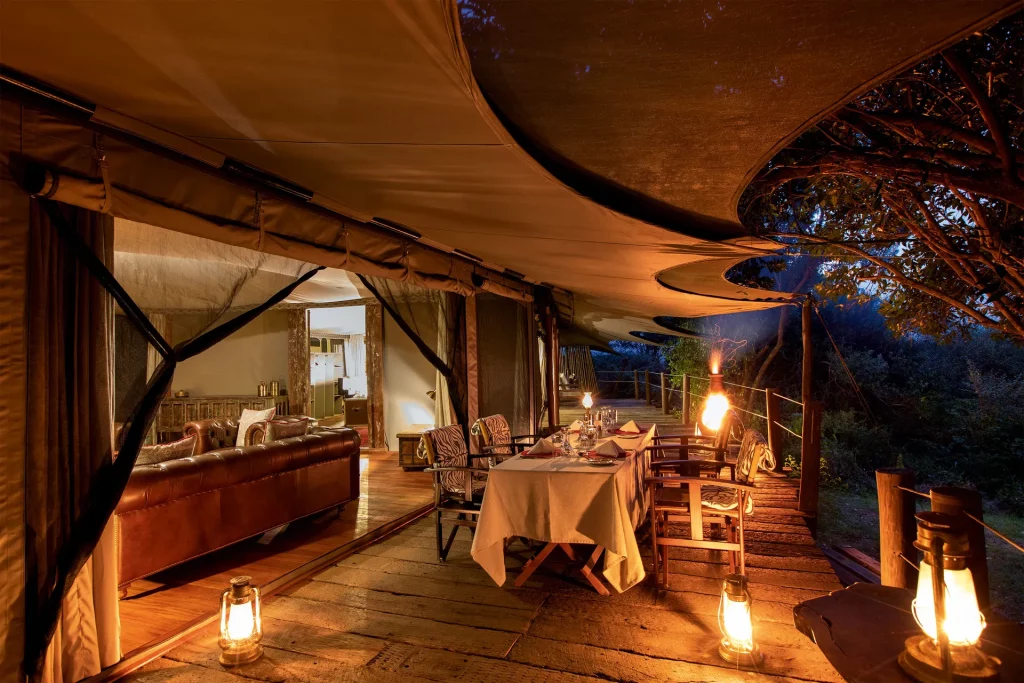
Mara Plains Camp – Masai Mara, Kenya
This small, remote camp combines a splash of Indiana Jones with a great dollop of luxury in the middle of Kenya’s Masai Mara. Tents are spaced apart amid a cluster of acacia trees, where the only sound at night is the occasional snort of a buffalo. The place has the air of a Thirties film set, with wooden campaign furniture and Eastern-inspired carpets. But channelling wilderness camping on a seven-star level is the new Mara Plains Jahazi Suite, a spacious two-bedroom tented pavilion set on raised railway-sleeper decking (past which a steady stream of wildlife parades). An indoor dining area leads to a private outdoor veranda and copper baths to melt into. By night, Mara Plains is an enchanting place: candles glitter in lanterns as chefs prepare dishes of tender grilled lamb, potato fritters, passion-fruit roulades and cheese platters with homemade chutney. Breakfast is a treat of orange-zest-flavoured pancakes and fresh coffee served on canvas chairs outside. Game drives reveal a pride of lions sprawled on a rocky escarpment, a breathtaking sight as cubs frolic and snooze in the pampas grass. Other wildlife surprises include kudus, fork-tailed drongoes, hippos mating in the river and mongoose hurtling across rutted tracks. This is the African safari dream, remote and restful, skies with fleeting Daliesque cumulus cloud formations in a landscape untouched for millennia. Geordie Greig
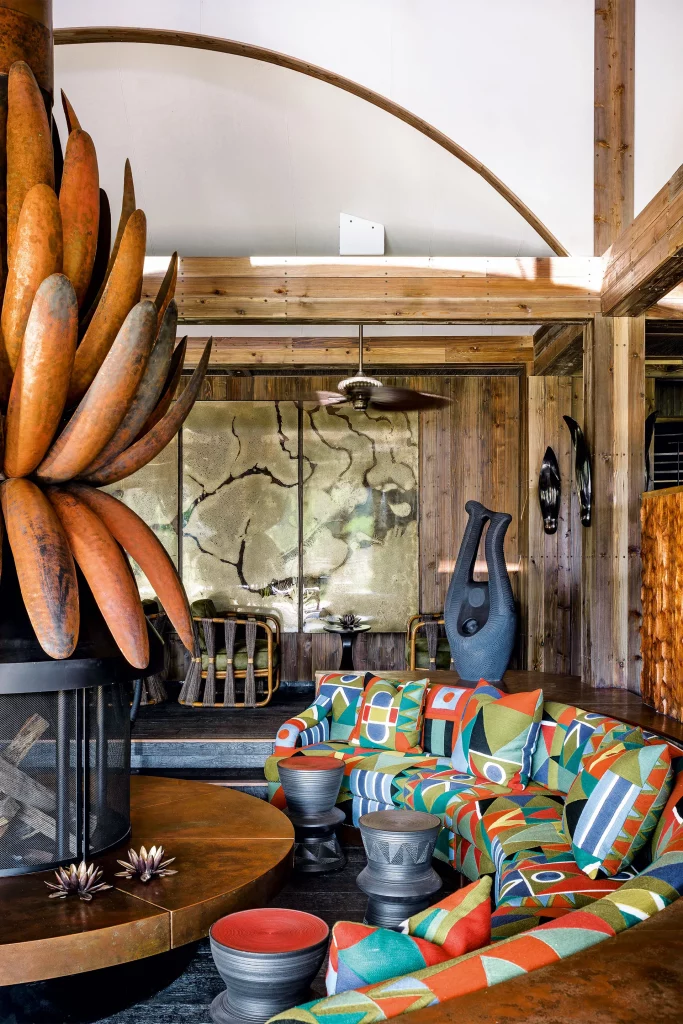
Xigera Safari Lodge – Okavango Delta, Botswana
Sitting in the richly biodiverse Okavango Delta, Xigera has lions, leopards and semi-aquatic red lechwes on its doorstep. What’s maybe more surprising about this opening from global operators Red Carnation Hotels is that it’s home to one of the world’s largest collections of South African art and design, curated in collaboration with Cape Town’s forward-thinking Southern Guild gallery. This commitment to art shines in everything guests see and touch, from handmade black clay coffee cups by Cape Town ceramicist Chuma Maweni to the dining tables with warped fairy-tale legs by Kenya-born artist Stanislaw Trzebinski. The food is a few notches above most safari fare: a team of five bake the lightest, flakiest pastries for morning game drives and six-course chef’s-table meals, with each chef given free rein to follow obsessions (one menu has a dish dedicated to the much-overlooked onion). Food waste is composted and given to local farmers for free, with vegetables purchased back from them. Herbs are bought from a female-run collective in Maun, the closest city. The 12 suites, reached by a series of raised light-impact wooden walkways, are so large that the super-king beds look modest. Each is different, but all have statement lamps, colourful patterned sofas and indoor and outdoor rain showers stocked with all-natural tulip- and yuzu-scented toiletries. A remote three-storey steel baobab tree with a roof deck can be booked to sleep out in the bush itself. Hannah Summers
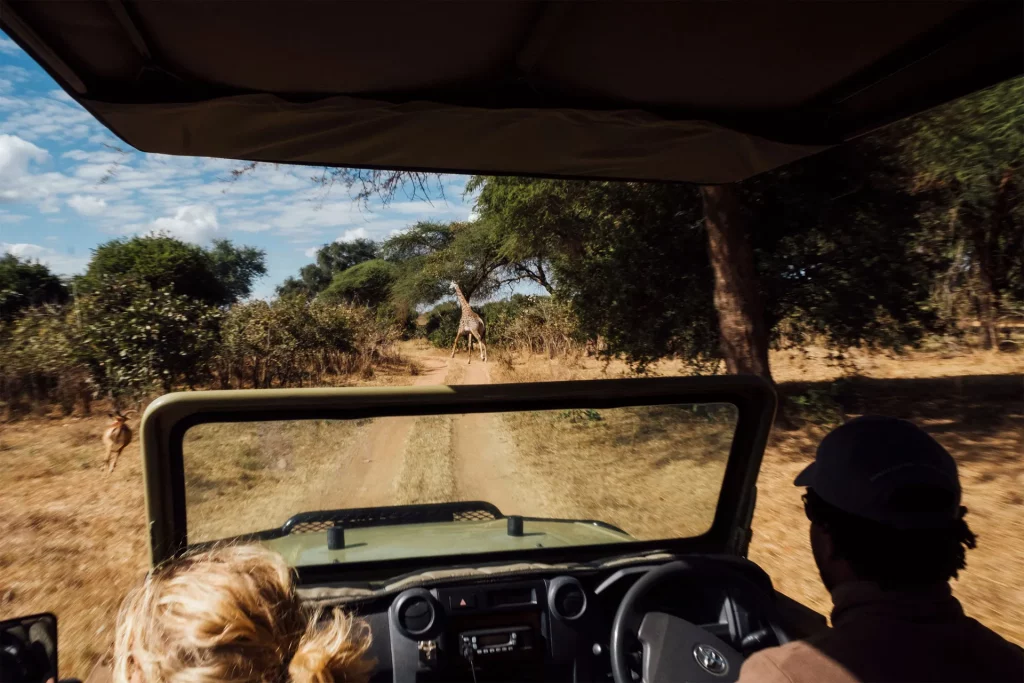
Usangu Expedition Camp – Ruaha National Park, Tanzania
Ruaha is one of those wildernesses that safari lovers keep to themselves. Unlike the busy Serengeti, Tanzania’s second biggest park has just 12 camps, and no one had ventured to this particular corner for decades until this summer, when Asilia constructed a light-footprint camp in the Usangu Wetlands in the far south. Poachers roamed freely and unchecked rice farms on the park’s perimeter drained the Ruaha River. Conservationists hope the opening of an expedition camp here will halt this destruction with the help of visitors. When not relaxing in the four solar-powered, mesh-fronted rooms overlooking the plains, guests help guides with research on game drives. Each of the camp’s recycled ethanol-powered four-wheel-drives is fitted with technology to feed information back to the Eco-Research Centre: telemetry systems to track collared cats, GPS radios to pinpoint sightings and thermal night cameras to spot nocturnal creatures. Half of the 16 Tanzanian staff are young villagers who are relishing Asilia’s training – from guide Anderson Pakomyus Mesilla, who three years ago didn’t speak English and now reels off Latin tree names, to Aly Mang’unda, the 22-year-old chef, who creates delicious dishes using just a fire. Beside each room is a square-netted star tent, so guests can sleep with the Milky Way above and the sounds of lions and hyenas roaring and whooping around. Treats on game drives include huge herds of topis, alongside sables, roans and cheetahs. Lisa Grainger

